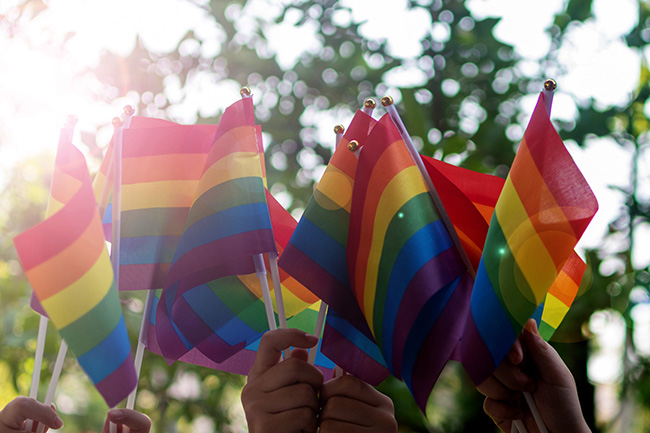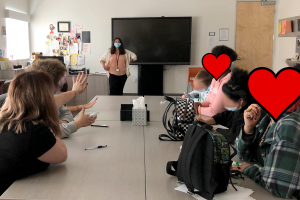
Working With LGBTQIA+ Youth: Things To Keep In Mind
By Julia Malecky, ASW
Camino a Casa Clinician
PRIDE month, which takes place every June, is a time for everyone to embrace and celebrate who they are. It is a time to celebrate love and the freedom to be, wholeheartedly, one’s true self. For those who do not yet feel comfortable, safe, or supported enough to be who they truly are, June is just another month during which they must hide and pretend.
In the field of mental health, we often come across youth who are struggling to understand who they are. This can include difficulties in understanding their gender identity, gender expression, and sexual orientation. We may also come across youth who know exactly who they are, but do not feel supported enough to outwardly express how they feel on the inside. This can have detrimental effects on a youth’s mental health.
Compared to that of cisgender heterosexual youth, the rate of suicide attempts is four times greater for LGBTQIA+ youth. In a national study, 40% of transgender adults reported having made a suicide attempt in their lifetime—92% of those individuals made their attempts before the age of 25.
Beyond suicide attempts, rates of substance use, homelessness, sexual abuse, verbal assaults, physical assaults, and even arrests are all significantly higher for LGBTQIA+ youth compared to cisgender and heterosexual counterparts. Family and peer acceptance are increasingly important for LGBTQIA+ youth. Even an attempt to accept and understand a youth who is questioning, transitioning, or exploring the various parts of their identity can make a huge difference in the youth’s life and future outcomes.

Julia Malecky, ASW Camino a Casa Clinician, leads a weekly MyDentity meeting, a safe space where Camino a Casa youth can discuss and explore issues around sexual identity and gender expression.
How we can improve as professionals
As mental health professionals, there are many things we can do to support youth who are exploring different gender identities, expressions, and sexual orientations. First and foremost, it is important to familiarize oneself with the constantly evolving terminology and be open to learning. We don’t need to be experts in everything, but we do need to be receptive to feedback and be willing to improve in our service provision. Using gender-neutral language whenever possible (“folks” vs “boys and girls”), avoiding gender stereotypes (“Girls like cooking and boys like playing sports”), and refraining from assuming a person’s gender are some of the simplest ways to create a safe and welcoming environment for our youth. It is also important to ask a youth what their preferred pronouns are and what they would like to be called. Many youth who are transitioning or are questioning their gender identities choose new names and pronouns that better represent who they are and do not want to be called by their birth names, often referred to as “dead names.” Remember: it’s okay to mess up pronouns and names. When you do, simply correct yourself and move on.
- Ally: Someone who is actively accepting and supportive of the LGBTQIA+ community.
- Cisgender: Commonly referred to as “cis” a term used to describe a person whose gender identity aligns with the sex they were born with.
- Gender-fluid: A person who does not identify as a single, fixed gender, but has an open, fluid gender identity that may change.
- Gender non-conforming: A broad term for someone who does not live, dress or behave in a way generally accepted by societal rules and expectations based on gender.
- Genderqueer: Someone who rejects the typical notion that someone has to be male or female. May see themselves as both male and female, neither male or female or somewhere outside of those categories.
- LGBTQIA+: An acronym for lesbian, gay, bisexual, transgender, queer, intersex and asexual.
- Neopronouns: Words created to be used as pronouns that are gender neutral. For example Thon, E, Ae, Co, Ve, Xe, Per, Ey, Hu, Ze, Fae, etc.)
- Non-binary: Someone who does not identify exclusively as a man or woman. Can also be used as a term to include identities such as agender, bigender, genderqueer or gender-fluid.
- Pansexual: Used to describe someone who has the potential for emotional, romantic or sexual attraction to people of any gender, gender identity or sexual orientation.
- Questioning: A term used to describe someone who is exploring their sexual orientation or gender identity.
- Transgender: Someone whose gender identity or expression does not match the gender they were assigned at birth.
It is an extremely vulnerable experience for a youth to come out to the people in their life. When a youth does come out, it is important to validate, show acceptance and follow the youth’s lead in terminology. Provide accurate information that avoids myths and stereotypes to avoid causing the youth to feel shame and regret in their decision to come out. The research is clear: when youth feel supported, they have higher chances for success and happiness. Even something small, such as asking a youth what their preferred pronouns are, can have a significant impact on how supported, comfortable, and safe a youth feels.
At Casa Pacifica, we strive to ensure that all youth feel supported and safe, whether they are transitioning, questioning their gender identity, exploring their sexual orientation, or simply trying out a new style that better represents their true selves.
The Trevor Project Lifeline: (866) 4-U-TREVOR (866-488-7386)
This is a national 24-hour-a-day, 365-day-a-year, toll free and confidential suicide hotline for LGBTQIA+ youth.
http://www.thetrevorproject.org/



